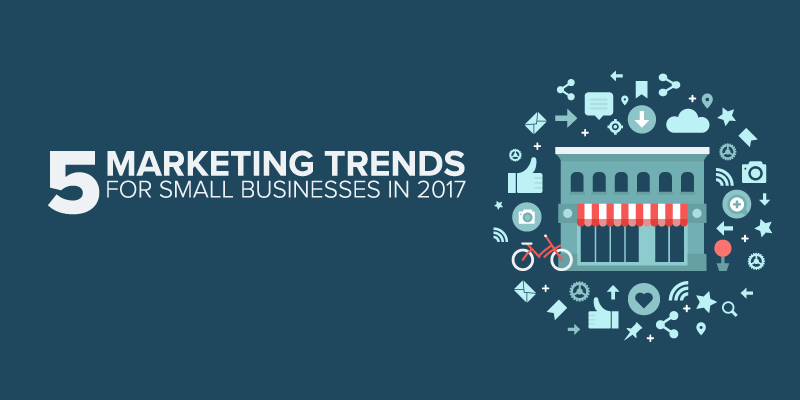 It is somewhat traditional to end off the year with a summary of emerging trends and predictions for the new year, but we understand that as a small business owner you probably want to spend the last few weeks of each year focusing on marketing, sales and customer service over the holiday season, not reading about what you should be doing in the new year. And sure, you could bookmark it to read at a later stage, but in all honesty, you know you’ll just forget about it hidden amongst all the other forgotten bookmarks.
It is somewhat traditional to end off the year with a summary of emerging trends and predictions for the new year, but we understand that as a small business owner you probably want to spend the last few weeks of each year focusing on marketing, sales and customer service over the holiday season, not reading about what you should be doing in the new year. And sure, you could bookmark it to read at a later stage, but in all honesty, you know you’ll just forget about it hidden amongst all the other forgotten bookmarks.
So instead, we held off publishing our look at 2017 marketing trends for small businesses until now, when you’re focused on the fresh start the new year promises. We have selected five marketing practices all small businesses should already be following, and then delve into evolving trends within those practices. And while some similar reports have touched on virtual and augmented reality, we haven’t; purely because although these could find more common use in marketing, they’re not at a stage where they are accessible to small businesses.
And this article is all about small businesses.
1. Mobile-Optimised Websites
For several years now businesses have been told to either adapt their websites to being mobile-optimised, or risk alienating a large number of visitors. This warning has been repeated so many times that one would think that only new users of the internet aren’t aware of it. However, a survey of small businesses by Clutch found that 23% of the respondents still did not have a mobile-optimised website, which isn’t too much of a problem if more than 70% of your website traffic is from desktop computers. But waiting for that number to drop below 70% before getting your website optimised for mobile devices is not going to be a wise strategy in 2017.
Why?
Because Google announced in October 2016 that they would soon be splitting their search index in two: a mobile index, and a desktop index, with the mobile index eventually becoming the primary index used to respond to queries. While a desktop index will be maintained (for now), it will not be as up-to-date as the mobile index, which could result in your website appearing much lower on Google SERPs. This isn’t Google ostensibly punishing anyone whose website isn’t mobile optimised, but rather responding to the fact that most searches on Google are done using a mobile devices. By prioritising the indexing of sites that are mobile-friendly, Google is able to return results that offer a better user experience regardless of the device used.
At this stage, there is no clear indication of when this change will happen, other than the “within months” statement made by Gary Illyes shortly after the October announcement.
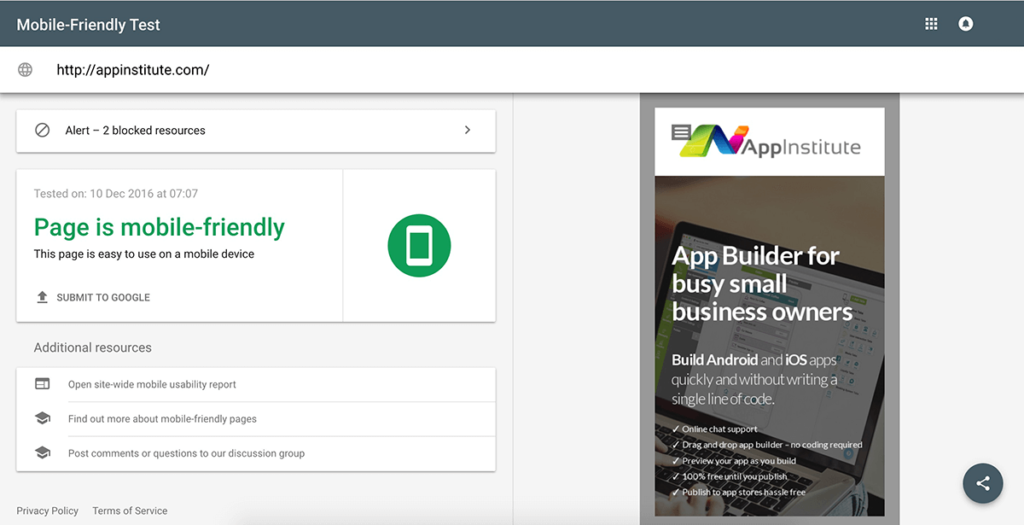
You can prepare for this by checking whether your website is optimised for mobile devices, and then finding a developer who is able to make it mobile-friendly. There are three popular techniques for making websites mobile-friendly, with a responsive website being the simplest solution for small businesses with relatively uncomplicated websites.
In addition to optimising for mobile SEO, integrating schema markup is another valuable strategy to enhance your website’s visibility. Schema markup helps search engines understand the context of your content, making it more likely to appear in rich snippets or answer boxes, which are increasingly prevalent in mobile search results. Furthermore, focusing on local SEO by ensuring consistent NAP (Name, Address, Phone number) information across directories can significantly boost your search rankings for mobile users who frequently seek local information. Ensuring your website employs AMP (Accelerated Mobile Pages) technology can further improve loading speeds, which Google recognises as a key ranking factor, particularly for mobile searches.
2. Mobile Apps
2015 and 2016 saw the launch of several tools and services that have made it incredibly easy – and affordable – for small businesses to launch their own mobile app. And although several outlets wrote about app overload in 2016 as if it were a new issue, it is actually something that has been discussed as early as 2011, with the two primary causes remaining the same. These are:
- Discoverability, and
- Relevance
There is no magic wand to wave and fix discoverability; there are steps you can take to try and improve it, but these are always tempered by the limitations of the app stores. Relevancy, however, is something you have far more control over, and therefore it is also something you should be continuously paying attention to.
Beyond push notifications, mobile apps can significantly contribute to customer engagement through features such as in-app messaging and personalized content feeds. In-app messaging allows businesses to interact directly with users, offering support or promotion at critical engagement points. Personalised content feeds can enhance user experience by delivering tailored content based on previous interactions, search history, or preferences. This approach not only boosts engagement but also strengthens brand loyalty by making users feel valued and understood. Implementing loyalty programs within the app can further incentivize continued use and repeat purchases by offering exclusive rewards or discounts.

3. Discoverability
App Indexing
Google App Indexing was launched in 2013, but only expanded to include iOS in 2015. App Indexing makes it possible for Google to crawl and index the content of your app, much the same as they do with your website. If anybody does a search using Google on a mobile device, and the content of your app is a good match for the results, the person searching will see one of two things:
- If they have your app installed they will see a result with an “Open in app” button which, when selected, will not only launch your app but also take them directly to the appropriate content.
- If they don’t have your app installed they will see an “Install” button which, when selected, will take them to your app in the appropriate app store.
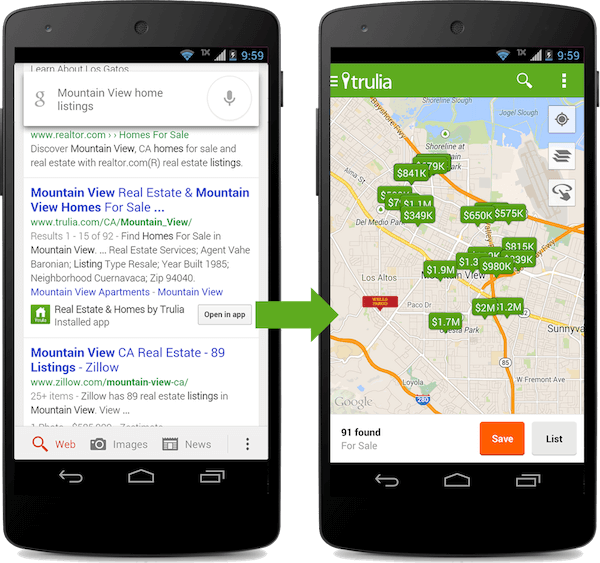 Source: Search Engine Watch
Source: Search Engine Watch
Unless you developed your app yourself, you should speak to your developer to find out whether they made app indexing possible, and if not, whether they can correct this.
App Store Optimisation
The biggest influence you have on the discoverability of your app is through app store optimisation (ASO), which is similar to SEO, but for your app, not your website. App store optimisation is not a new thing, but it is something that will continue to be extremely important until app discoverability experiences a major shift. App store optimisation depends on the following:
- App Name – Names are cut off after the first 25-30 characters, so even though you are allowed up to 50 character for iOS apps (30 characters for Android), the most recognisable part of your app name should fit within the first 25 characters. For most businesses this should be the actual business name, and while you can add a few relevant keywords after the name, Apple have started to enforce a rule regarding terms and descriptions that are not part of the app name.
- App Description – Only the first few sentences of your description are shown at all times, with users having to select the “more” link to see the rest. So while the description of your app should be as detailed as possible, including a full list of features and benefits, with strong use of relevant keywords, the first 1-2 sentences should be a concise and powerful summary of the app’s features.
- App Icon – Like the name of your app, your app icon should be instantly recognisable to users already familiar with your business, yet clear and distinctive enough to entice new users. There is nothing wrong with using your business logo, as long as it has been properly adapted to the correct dimensions.
- Keywords – Keywords are an extremely important part of app discoverability, with Apple having a separate keyword field (with a 100 character limit), while Google only looks for keywords in your app description. Given the impact keywords can have on app discoverability, selecting them is not a 5-minute task. Watch out for our upcoming guide on keyword research and selection.
- Localisation – Localisation is closely linked to keywords, and involves one of two approaches. The first is translating your app description and content into a foreign language which, unless you are specifically targeting a non-English market, isn’t necessary for most small business apps. The second, however, is quite relevant to businesses targeting different geographical locations, and involves adapting your keywords to that market. A business targeting both US and UK users would not only have to change the spelling of some keywords, but also research which keywords are most relevant to each market. This too will be covered in more detail in our upcoming keyword research guide.
- App Category – A final aspect of ASO worth reassessing is the category your app is listed under. Don’t simply accept that the current category is the best one without looking at what category your competitors are listed under. An additional factor to consider is whether your users would associate your business with this category; after all, these are the people you are trying to reach, and it won’t help if your users are looking for you in the wrong place.
Relevancy
While your efforts to improve discoverability will always be affected by factors you have little control over, making your app highly relevant to your target audience is something you have full control over. And relevancy, more so than discoverability, is what decides the success of your app: it is what users look for when deciding whether or not to install your app, and relevancy is what then influences whether or not they use your app regularly, and whether or not they keep your app installed on their device. It is foolish to believe that your app will be relevant to your existing customers merely by virtue of them being – well – customers. You need to make them – your customers – aware of how they will benefit from using your app in addition to supporting you. And the benefits should not be general, but personal.
Personalisation
Something that businesses have become very aware over the last few years is the impact that personalization has on how customers respond to marketing and offers, with the expectation of personalization only growing among customers. Even if you have begun experimenting with personalization, it is worth revisiting at the start of 2017 – in the UK alone the number of customers willing to share personal information and preferences in order to receive personalized offers jumped from 35% in 2015, to 43% in 2016. Key factors to consider when implementing or enhancing personalization, especially through your mobile app, are:
- Collect only the information you need, and only as much as your customers feel comfortable sharing. 1 in 4 customers still find that personalisation borders on an invasion of privacy.
- Don’t only personalise according to segments – or personas – but at the individual level too. One-to-one marketing is becoming accessible to small businesses now, with a mobile app a good platform on which to begin testing it.
There is an element of nostalgia that drives personalization, with Boomers and GenXers remembering a time when most of their shopping was done in small businesses, where the owner and assistants not only knew your name, they also remembered what you frequently bought, and what you liked and did not like. Even for Millennials, it replaces the feeling of being nothing more than a credit card with that of being an individual.
Individual areas of your app where you can focus on personalisation are:
Push Notifications
Although push notifications have a bit of a mixed reputation, there was a small increase in the number of users enabling push notifications between 2014 and 2015. If businesses continue to be honest and smart about the use of push notifications, this figure should continue to climb. Being honest is about stating clearly in your app description how push notifications are used – and following through with that “promise” – and possibly waiting for users to use the app once or twice before asking them to enable push notifications – which helps build trust.
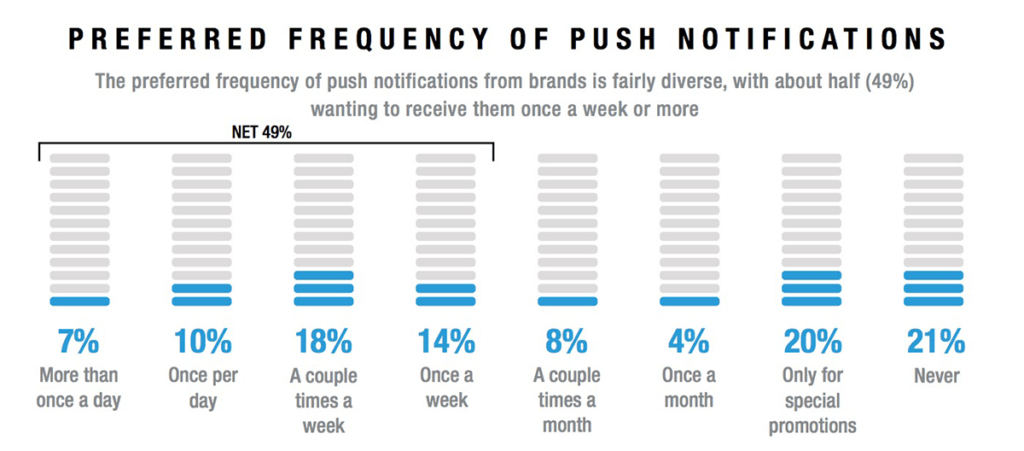
Source: Vibes Marketing
Being smart about the use involves not sending push notifications too frequently – once or twice a week at most – sending them at the right time, and sending out personalised, small batch notifications, rather than a mass push to all users. Push notifications are not only a great feature for using personalisation, but it is also a feature that lends itself very well to one-to-one marketing.
Geo-Location Notifications
The fraternal twin of push notifications, using geo-location to send out highly targeted messages also works better when those notifications are personalised. Geo-location notifications are particularly useful for businesses that rely on foot traffic, especially if the business is located just outside of a high-traffic area, and the targeting zone is expanded to include the high-traffic section. Personalisation should still be a priority with these notifications, but one-to-one marketing is less important. General announcements, such as a store-wide promotion, or change to trading hours, can be pushed to all users entering your targeted area.
Loyalty Programs
We live in a time where it is now possible to pay for your purchases without reaching for your wallet or purse, so why are you still expecting your customers to carry a tatty old loyalty card? If your business has a loyalty program, but you haven’t yet enabled a digital version of it in your mobile app, 2017 is the year you should knuckle down and do it.
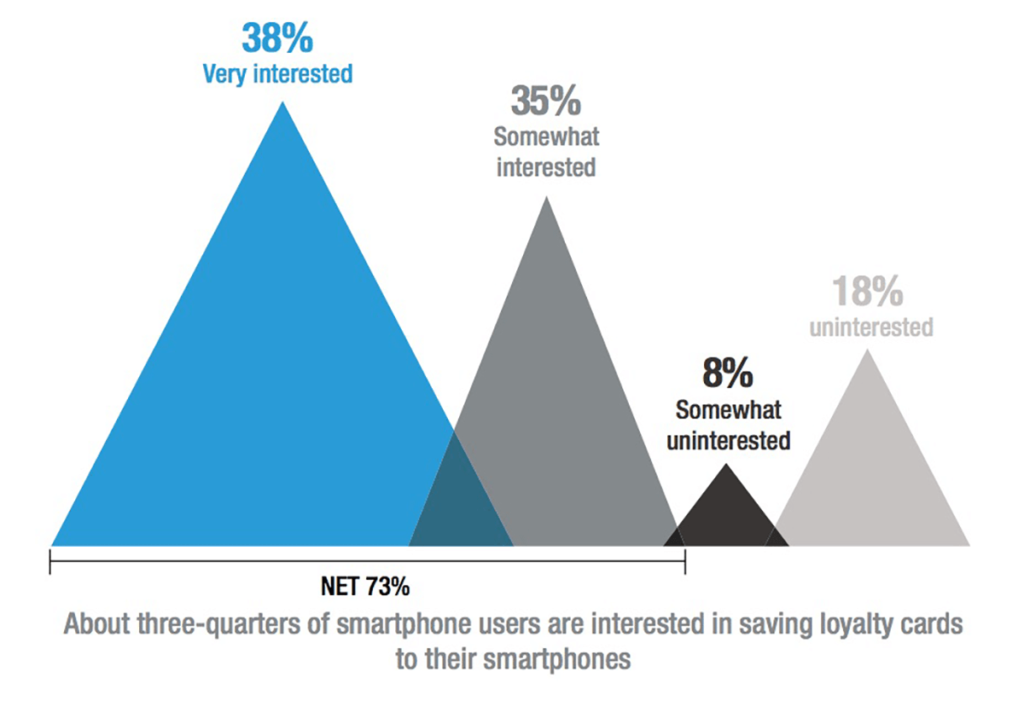 Source: Vibes Marketing
Source: Vibes Marketing
Vibes Marketing’s 2016 Mobile Consumer Survey showed that 73% of smartphone users are interested in saving their loyalty cards to their smartphone, with 63% of users stating they would also have a more positive opinion of a business that offers digital loyalty cards. But, as with push notifications, the benefit to both you and your customers is even better if the loyalty program is somewhat personalised – both purchasing requirements and rewards. The one-size-fits-all approach only worked in the past because you had no easy way to track and analyse user behaviour, which changes once you incorporate the loyalty program into your mobile app.
For more tips and tricks on optimising your app visit Ymedialab’s optimisation guide.
Cross-Platform App Development
Developing apps across multiple platforms can significantly enhance accessibility and user reach. With frameworks like React Native and Flutter, small businesses can create apps that perform efficiently on both iOS and Android devices without the need for separate development teams. This approach streamlines the development process and reduces costs while maintaining high levels of quality and performance. Analysts suggest that cross-platform development can reduce time-to-market, allowing businesses to swiftly respond to customer demands and market changes. Opting for a cross-platform strategy can prove beneficial in maintaining a consistent user experience across devices, which is crucial for customer retention.
Another advantage of cross-platform app development is its ability to integrate seamlessly with other digital channels, creating a unified experience for users across platforms. By using tools that support integration with existing CRM systems or social media accounts, businesses can maintain a cohesive brand presence. Additionally, cross-platform development can facilitate easier maintenance and updates, as changes can be implemented across all platforms simultaneously. This is crucial for small businesses that may have limited resources but need to keep their apps updated with the latest security patches or features. Adopting a cross-platform strategy can also help businesses quickly implement user feedback, ensuring that the app continuously meets customer expectations and enhances user satisfaction.
4. Native & Live Video
If the growth in popularity of video during 2016 was nothing more than a temporary trend, we would not be seeing the massive push to integrate them into popular social networks that continued right through to the end of 2016. Facebook and Snapchat have been on board for some time now, but as 2016 drew to a close we had the surprise introduction of live video on Instagram and Twitter. If what the bigger social networks are doing is not enough to convince you, maybe the following facts and predictions will:
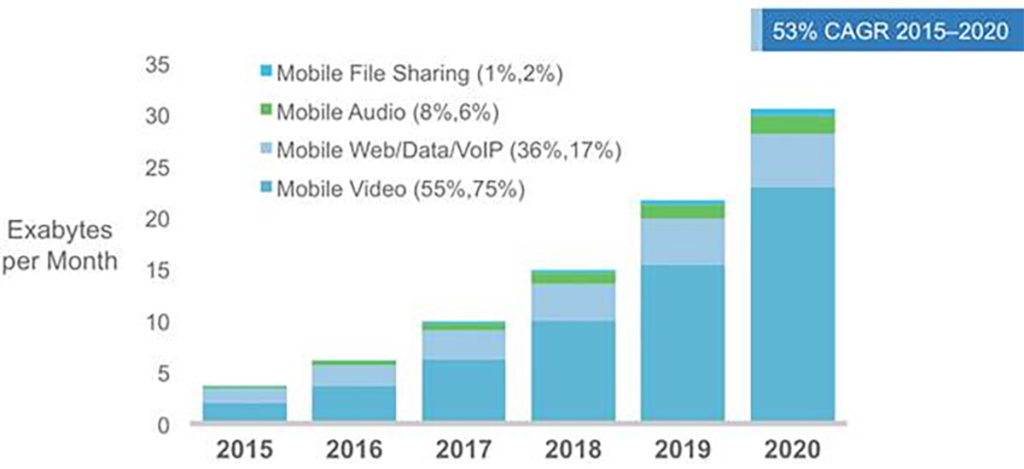
Source: Cisco
- By 2020, 75% of the world’s mobile data traffic will be video.
- In the US, YouTube reaches more 18-49 year-olds than any broadcast or cable TV network.
- More than 100-million hours of video are watched on Facebook every day.
- In the first half of 2016, time spent watching video content on Instagram increased by more than 40%.
- Snapchat users watch an incredible 10-billion videos per day.
- The average internet user spends more than 16-minutes watching online video ads every month.
- 90% of user say that watching a video about a product helps their decision making.
- 92% of mobile video consumers go on to share videos with others.
- 46% of users take some sort of action after viewing a video ad.
- 64% of users are more likely to buy a product online after watching a video.
Source: Cisco, Tubular Insights and Insivia
Long-form written content isn’t being usurped by video, but video does make it possible to appeal to a larger audience, particularly when it comes to mobile devices. In 2017, video should not only be an important part of your social media strategy, but also of your ecommerce strategy (for businesses with an online store) in the form of product videos.
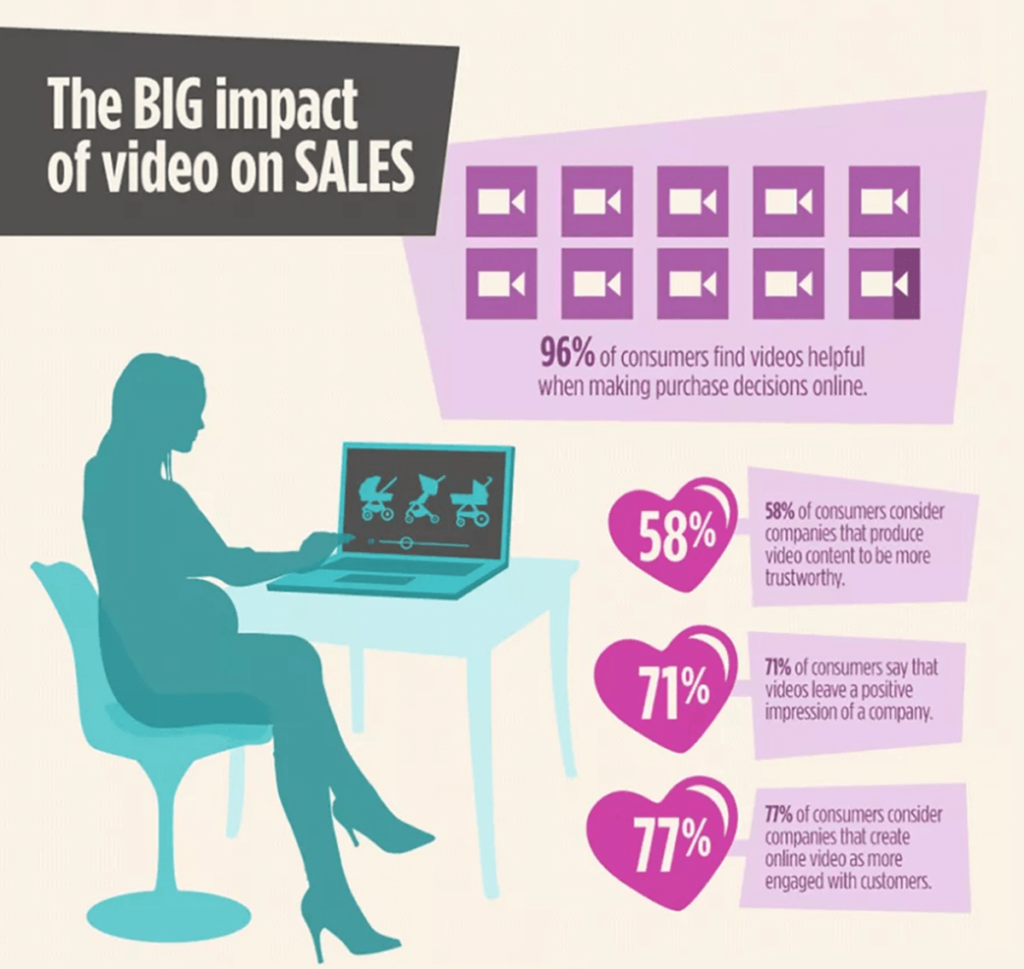 Source: Animoto
Source: Animoto
An eye-popping 96% of customers find videos helpful when shopping online, and 58% of customers find businesses who use video content more trustworthy. When adding product videos to your online store, they should:
- Be placed on the product page, not a separate page.
- They should be placed close to the conversion points of the respective product pages.
- Be high-quality, and actually showcase the product. A video consisting of a static image with voice narration of the features and benefits is not a product video. Where possible show the product being used, and from multiple angles.
- Not be too long. For complex products, your videos can run up to 5-minutes long, but for most products aim to keep the length below 60-seconds.
- Possibly include user-generated content. You don’t need to create your own videos for every product you stock. Search through YouTube for videos created by actual customers, where the primary features and benefits are discussed and demonstrated.
When it comes to adding video content to your social media accounts, however, it should follow the same practices you already have in place for your social media strategy. This means focusing on the networks used by your target audience, and making sure that the videos you share appeal to that audience. General demographic surveys show that:
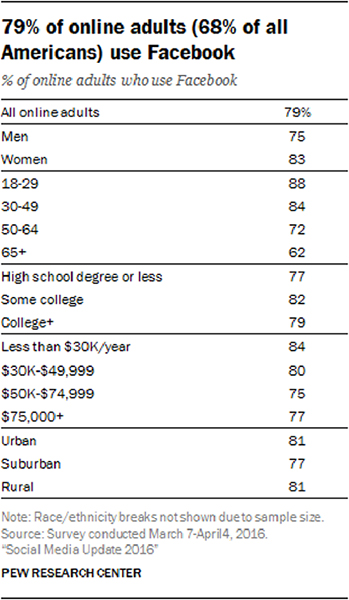
Source: Pew Research Center
79% of online adults use Facebook, with a generally even spread across the different age groups, though it skews slightly towards female users.
It’s important to consider the storytelling aspect of video content, which should captivate audiences from the very first second. Given the diverse consumption habits on platforms like Snapchat and Instagram, businesses can experiment with vertical videos to better fit the mobile screen, providing a more immersive experience. Incorporating interactive elements, such as polls or clickable links, can further engage viewers and encourage them to take immediate action, such as visiting your website or purchasing a product. By aligning your video content with these platform-specific trends, you can maximize engagement and improve overall effectiveness of your marketing efforts.
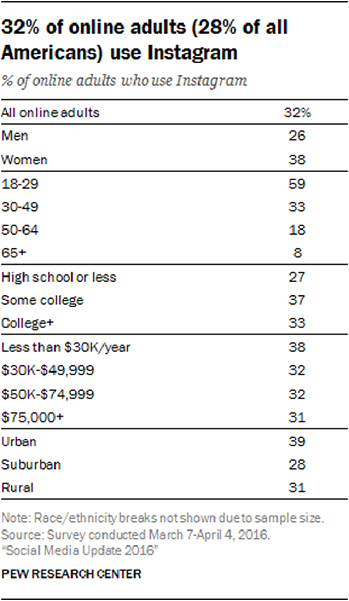
Source: Pew Research Center
32% of online adults use Instagram, with it being most popular with users in the 18-29 and 30-49 age groups. Instagram skews more heavily towards female users.
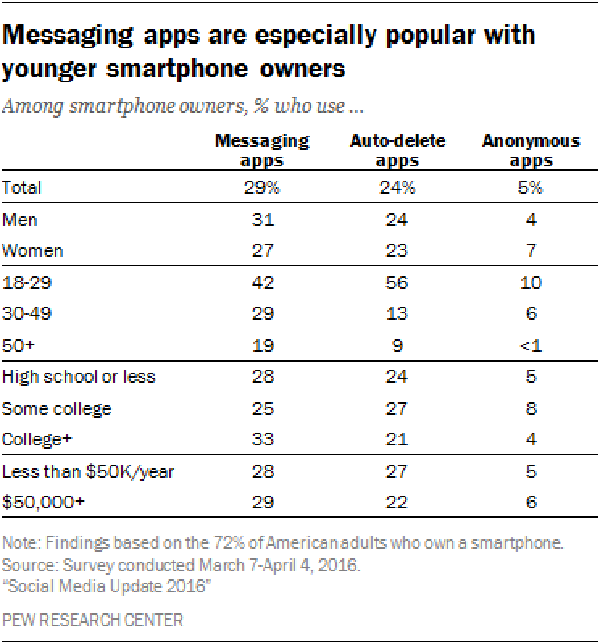
Source: Pew Research Center
Although Pew Research Center measures Snapchat as a messaging app, it is accessible to businesses, and should not be ignored by anyone targeting the 18-29 age group, with 56% of users falling in that group. It is almost equally popular with both male and female users.
You use of video on Facebook, Instagram and Snapchat should not only take into consideration your target audience, but also the limitations and best practices for each network. Small businesses with limited resources may find it difficult to use video effectively on all three of these networks and should instead focus on the network with the largest share of their target audience.
There are two entry points to video on Facebook for businesses: the first is native video (video content uploaded directly to your Facebook Page, rather than embedded YouTube or Vimeo video), and the second is Facebook Live. Native video has been around for awhile on Facebook, although it was only in 2016 that brands started using it more frequently. Facebook Live, however, only became widely available during 2016, but there is little doubt that Facebook is prioritising Live video over other content. Barely three months after rolling Live video out to all iOS users, Facebook announced that Live videos were watched 3x longer than non-live videos, and then adjusted the Newsfeed algorithm so that Live videos would appear higher than other content. Both live and native video require some planning to pull off successfully, and as with any marketing efforts, you should have a solid strategy that guides you with your use of video on any social media platform. Before looking at what some brands are doing with live and native video, you should be aware of best practices for both.
Native Video on Facebook – Best Practices
- Most video types are supported, but MP4 is recommended
- Video resolution should be 1080p or under.
- Although video of up to 45-minutes is allowed, the optimal length is 30-60 seconds. Only go longer than 2-minutes if the content is truly compelling.
- The video should work both with and without audio. Many users mute the audio on videos, so use closed captioning and text overlays to convey the most important parts of your message. But avoid using the automated captioning feature of Facebook, which can be more confusing than helpful.
- Optimise your video for mobile devices, ensuring that any text you use in the video are still legible on a mobile screen.
- Ditch the intro and get straight to the content. Your video is showing up on a timeline that users are scrolling through; they aren’t going to hang around waiting for the good stuff.
Although the product video for Redsbaby Bounce runs a little longer than 60-seconds, the pacing is great, not to mention they do an awesome job of showing features and benefits in action, accompanied by relevant text overlays.
Live Video on Facebook – Best Practices
- Make sure you broadcast from an area with a strong signal. WiFi is best, but if you have to switch to using a mobile connection, you would want that to be 4G.
- Announce your live broadcast a day ahead time with a written post on Facebook, and on other platforms where your audience is quite active. Give the exact time(s) you will be live.
- Write a clear description of what will be happening during your live broadcast: are you going to be demonstrating one or more products, are you going to be responding to viewer questions, etc. Your description appears with your video, and helps viewers decide whether or not to tune in.
- Remind viewers to tap on the Follow button that appears during a live video, so that they can be notified automatically of future live broadcasts. Try to respond to viewer comments and questions in real time, and use each person’s name in your reply.
- Try to follow a consistent schedule, always broadcasting on the same day, and at the same time. This helps create anticipation, and can help build an audience of both past viewers and new viewers. However, you should remember that if you are broadcasting during the day, many people will be busy at work, or school. Experiment with broadcasting during the 1pm to 3pm period, when people take a lunch break, or between 6pm and 9pm, when people are at home, and winding down.
- Have a clear idea of what you want to do, and what you hope to achieve, but don’t be afraid to experiment a little. You can do Q&A sessions, where your customers ask questions (about your business or specific products), you can do product launches and product demonstrations, and you can even take your audience behind-the-scenes, with restaurants giving a tour of the kitchen, and retailers showing what happens in the warehouse.
- Try to broadcast for at least 10-minutes, but experiment with longer broadcasts to see how it impacts on your audience size.
- Remember that live broadcasts are automatically archived by Facebook, so a video of your live broadcast will still be available for anyone who missed it.
- Always end off with a closing line to announce the end of the live broadcast. If you already know when you will be broadcasting live again, announce the date and time.
Benefit Cosmetics have a great Facebook Live strategy, with each broadcast focusing on a specific topic, and viewers invited to submit their own questions relating to the topic.
Instagram and Snapchat
In mid-2016 Instagram launched a new feature that appeared to be directly copied from Snapchat, right down to the name – Stories. On both platforms Stories are collections of photos and 10-second videos that you share with your followers. You create a Story by selecting photos and videos, editing them by adding doodles, stickers and text, and then deciding who can view them – either your entire audience, or only selected followers. Each Story you create is only available for 24-hours, after which it ‘disappears’. There are subtle differences between Snapchat and Instagram Stories, and the most important difference for brands to consider is the audience. Instagram is used by more people than Snapchat, and while Instagram’s largest audience is within the 18-29 age group (similar to Snapchat), it still appeals to a significant number of 30-59 year olds. Additionally, Instagram’s audience still skews towards a larger female audience, while Snapchat is fairly balanced amongst male and female users. So deciding whether you are going to focus on Instagram or Snapchat depends on whether you only want to reach 18-29 year olds, and whether you are appealing to mostly men, women, or both genders. This infographic by One Productions explains the other differences between the two platforms:

Snapchat & Instagram Stories – Best Practices
- Except in the case of a special event, Stories should be 1-2 minutes long. Consider too what your Story is saying: individual users can get away with a seemingly random collection of images and video clips, but, as a brand you should be sharing a Story – beginning, middle, and end. What should a user want to do after watching your Story?
- If you clip includes audio, talk directly to your audience. And remembering that your Stories will be viewed on mobile devices, stick to shooting in vertical mode.
- When adding text, make it more legible by adding a contrasting shade behind the text: if using white text, use a darker shade behind it, and with black text, use white or another light shade.
- Plan your Stories. As stated earlier, your Stories should not be a hodge-podge collection of images and video clips.
- Look at what other brands are doing with Stories and see how you can adapt this for your own audience.
- Analyse what works, and adapt your strategy accordingly. Don’t be afraid to experiment, as long as you pay attention to the results.
Instagram also launched Live Video towards the end of 2016, and while the feature isn’t available to all users yet, it is worth considering once it is. Instagram Live is very much like Facebook Live – and can be used in similar ways for marketing purposes – with the big difference being that – unlike Facebook Live – there is no archive of your live broadcasts; your followers will not be able to rewatch any of your past live broadcasts.
The temporary nature of both Stories and Instagram Live position them well for short-term marketing efforts, particularly those designed to create a sense of urgency, and drive immediate results.
GrubHub and Everlane were both early adopters of Snapchat, and both show how other brands can cleverly use Snapchat (and Instagram Stories) to engage with their audience.
GrubHub’s SnapHunt campaign encourage user engagement in the form of contests, and because it ran over a number of days, it also encouraged users to return each day to see what the next SnapHunt involved.
Everlane takes their fans behind-the-scenes with longer Stories covering everything from factory tours, to spending the day with their creative team.
Twitter has supported live video ever since acquiring Periscope in 2015, but the feature was only accessible through the standalone Periscope app. But on 14 December 2016, Twitter announced that watching and broadcasting live video would now be possible directly from the Twitter mobile app. This is great news for businesses whose audience is most active and engaged on Twitter, giving them access to similar features as found in live video on other platforms. And unlike Instagram Live, your live broadcasts can be rewatched by anyone, at any time.
Content Marketing
Content marketing is an important part of most marketing strategies, but it is only effective if it is adapted to the ever evolving wants and needs of your audience. Which means in 2017 you should be looking at the following as part of your content marketing strategy:
Purpose-Driven Content
Purpose-driven content is an offshoot of purpose-driven marketing, and with Millennials placing a high-value on businesses that aren’t driven purely by the pursuit of profit, but also by bringing about change in the world and the lives of their customers, it is a trend that should not be ignored by any business with a sizeable Millennial audience.
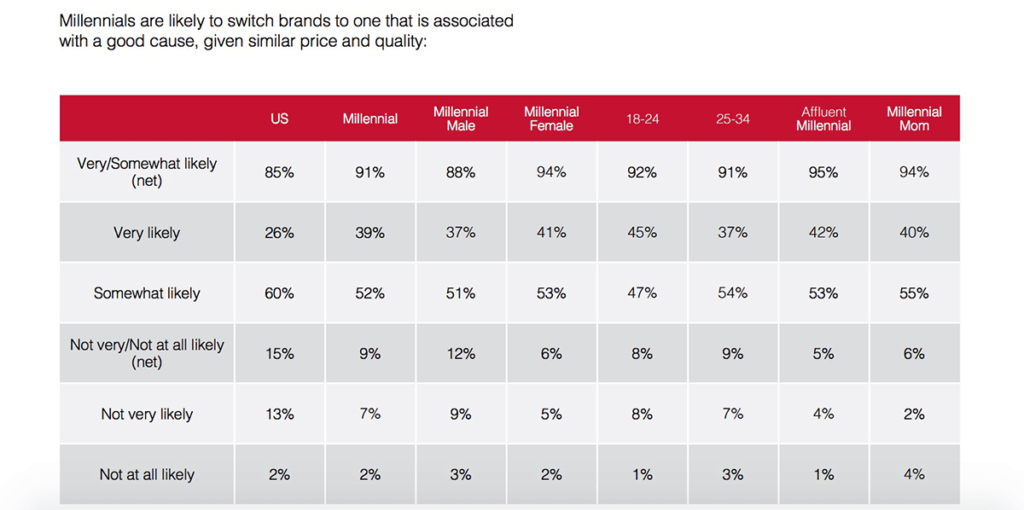
Source: Cone Communications
While purpose-driven marketing is focused on aligning your business with a cause, and then highlighting this in your marketing, purpose-driven content can either emphasise how when customers support you they also support a specific cause, or it can focus on having an impact on the lives of your customers.
- Home Depot not only offer free in-store DIY workshops, but their website includes a library of detailed instructions on how to complete certain DIY projects. Each project is broken down into steps, with video clips for each stage of the project, and you will even be given a handy list of all the tools and materials you will need.
<p style="color: #c9c8cd; font-family: Arial,sans-serif; font-size: 14px; line-height: 17px; margin-bottom: 0; margin-top: 8px; overflow: hidden; padding: 8px 0 7px;
- Toyota USA previously ran an Instagram campaign where they would donate $50 to Boys & Girls Clubs of America for every selfie posted using a specific hashtag, and in 2016 they ran a similar campaign linked to United Way Worldwide.
- 2017 should be the year you not only identify causes that are important to you and your audience, but also find ways in which you can use your content to make a positive impact on the lives of your customers.
Influencer Marketing
Most businesses have benefitted from a rudimentary form of influencer marketing at some point – word-of-mouth. But as a business owner you have no real control over how word-of-mouth spreads; you don’t know how big the circle of influence is, or even if it includes anybody from your target audience. True influencer marketing is different because you not only get to select the influencer, but you also control what they will be marketing. And with the proliferation of influencer marketing platforms, it is very much within reach of small businesses.
In simple terms, influencer marketing is getting someone else to spread your message, through a review of your products, your business or your services – either written or video. These reviews are exposed to the influencer’s audience on their website, and their social media network, with the benefit being that this type of marketing:
- Helps build trust. People are inherently more likely to trust an endorsement coming from an individual they trust, rather than from a business.
- Helps you reach a niche audience that closely matches your target audience.
Can be very cost-effective, with a better return on investment. For small businesses targeting smaller audiences, the monetary cost is usually minimal, and sometimes all that is required is sending a package of products to each influencer.
Before making use of any of the influencer marketing platforms, it helps to:
- Define your goals – are you looking at increasing brand visibility or increasing sales? Knowing this will help you find the right influencer for your campaign.
- Define your intended audience – you are not simply selecting the first influencer you come across. Knowing who you want to reach will help you select the influencer whose own network matches your target audience.
- Compile loose guidelines – specify what you would like influencers to focus on and mention, but don’t be too rigid. They already have their own “voice” which shouldn’t change to match yours, or you risk overriding authenticity.
Personalisation
Personalisation is a big trend that touches on multiple areas of your marketing, including content marketing. Although personalisation in marketing can be narrowed to one-to-one campaigns, this isn’t what you would be looking at in your content marketing.
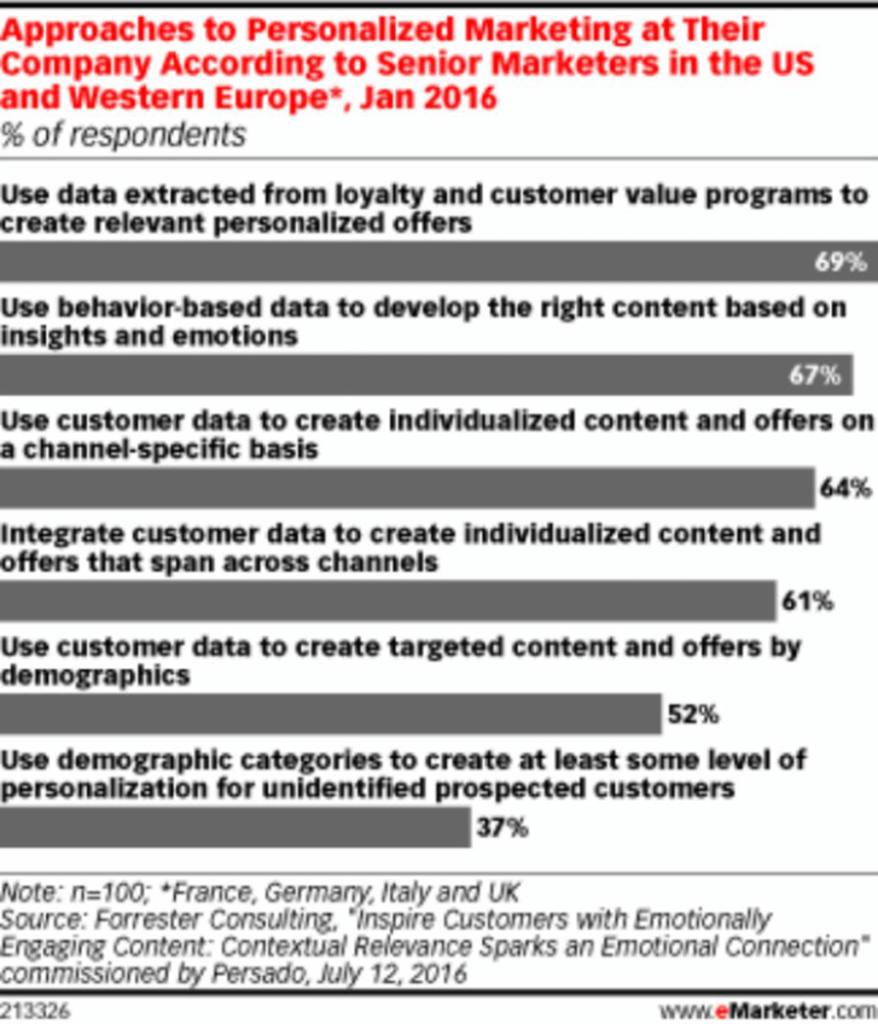 Source: eMarketer
Source: eMarketer
Instead personalisation in content marketing will see you paying more attention to audience behaviour and demographics, and customising your content accordingly, not only in the form of what offers you promote (and on which platforms), but also in terms of content designed to help or benefit your audience. If you share posts or videos that cover the features and benefits of certain products, are you selecting products randomly, or according to what is popular with your customers?
Check out ConversionXL’s personalisation guide to learn more.
5. Search Engine Optimisation
Search Engine Optimisation (SEO) is an ongoing task for any business with a website, with any changes to search algorithms affecting how your website ranks, and how you implement certain marketing practices. It is impossible to discuss these until they are announced, but there are two factors to consider early in 2017: popups and page speed.
Popups
In the early years of the internet, popups rapidly became the bane of browsers until the spread of popup blockers tamed the use of popups. But marketers recently rediscovered popups, and found that they were no longer hated, and generated some interesting results. However, it did not take long for some marketers to become a little too enthusiastic with the use of popups, turning them from something that wasn’t too bad, back to something that is not only annoying, but also horribly intrusive, particularly on mobile devices. As part of their effort to continually improve website accessibility on mobile devices, Google announced that after 10 January 2017 websites using popups, interstitials and other techniques affecting website accessibility may rank lower in search results. You can check how your site performs by using both the mobile-friendly test, and the mobile usability report within Google Webmaster Tools (for more info on this: check out our SEO Guide for Small Businesses).
Page Speed
The mobile-friendly test performs multiple different tests when analysing any submitted URL, including a test on how quickly the website loads. This is an important factor to consider since:
[…] 30% of all online shopping purchases now happen on mobile phones. The average U.S. retail mobile site loaded in 6.9 seconds in July 2016, but, according to the most recent data, 40% of consumers will leave a page that takes longer than three seconds to load. And 79% of shoppers who are dissatisfied with site performance say they’re less likely to purchase from the same site again.
Think With Google
In addition to the mobile-friendly test, you can also run page speed tests using the Web Page Test to identify specific performance issues on your website. This test will also give suggestions on how to eliminate any identified performance issues.
Influence of Voice Search on SEO
Leveraging structured data can further enhance visibility for voice search queries, as this helps search engines discern the most relevant snippets of information from your site. As more search engines develop to support voice commands, businesses should consider optimizing their content with long-tail keywords and natural language. Voice search is largely performed on mobile devices, making mobile optimisation, including page speed and mobile-friendly designs, even more important. To better align your content with voice search results, consider developing content that directly answers questions using the “People also ask” feature seen in Google results. Investing in these strategies not only enhances accessibility for users relying on voice-activated devices but can also set your business apart as a leader in adopting forward-thinking SEO practices.
The online marketing space changes frequently, and quite rapidly at times, so this summary of marketing trends to follow and implement should not be considered in isolation. In particular, the use of video in your marketing strategy should be executed while constantly remaining aware of new developments, and shifts in usage and implementation among larger brands. Finally, none of these trends or practices should ever replace what you are already doing successfully; keep doing what works for you, and find ways of introducing, or trying, new strategies to complement or boost existing strategies.
And may 2017 be a very rewarding year for you and your small business.

Last Updated on January 31, 2025 by Ian Naylor
10 thoughts on “5 Marketing Trends for Small Businesses in 2017”